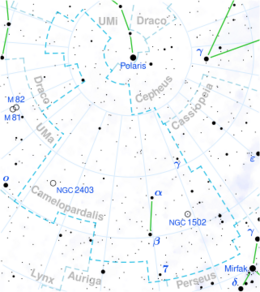Astronomy:51 Camelopardalis
| Observation data Epoch J2000.0 Equinox (celestial coordinates) | |
|---|---|
| Constellation | Camelopardalis |
| Right ascension | 07h 46m 40.07812s[1] |
| Declination | +65° 27′ 20.4266″[1] |
| Apparent magnitude (V) | 5.93±0.01[2] |
| Characteristics | |
| Spectral type | K2 III[3] |
| B−V color index | +1.18[4] |
| Astrometry | |
| Radial velocity (Rv) | −30.9±0.2[5] km/s |
| Proper motion (μ) | RA: +27.601[1] mas/yr Dec.: +17.656[1] mas/yr |
| Parallax (π) | 9.7528 ± 0.0372[1] mas |
| Distance | 334 ± 1 ly (102.5 ± 0.4 pc) |
| Absolute magnitude (MV) | +0.92[6] |
| Details | |
| Mass | 1.08[7] M☉ |
| Radius | 11.8+0.3−0.9[8] R☉ |
| Luminosity | 57.2±0.4[8] L☉ |
| Surface gravity (log g) | 2.25[9] cgs |
| Temperature | 4,626±122[10] K |
| Metallicity [Fe/H] | +0.00[11] dex |
| Age | 9.25[7] Gyr |
| Other designations | |
| Database references | |
| SIMBAD | data |
51 Camelopardalis (51 Cam), also designated as HD 62066, is a solitary star located in the northern circumpolar constellation Camelopardalis. It is faintly visible to the naked eye as an orange-hued point of light with an apparent magnitude of 5.93.[2] Gaia DR3 parallax measurements imply a distance of 334 light-years[1] and it is currently receding with a heliocentric radial velocity of −30.9 km/s.[5] At its current distance, 51 Cam's brightness is diminished by 0.17 magnitudes due to interstellar extinction[13] and it has an absolute magnitude of +0.92.[6]
51 Cam has a stellar classification of K2 III,[3] indicating that it is an evolved K-type giant star. It has a comparable mass to the Sun[7] but it has more than twice the latter's age at 9.25 billion years.[7] As a result, it has exhausted hydrogen at its core and it has expanded to 11.8 times the radius of the Sun.[8] It radiates 57.2 times the luminosity of the Sun[8] from its enlarged photosphere at an effective temperature of 4,626 K.[10] 51 Cam has a solar metallicity at [Fe/H] = +0.00.[11]
References
- ↑ 1.0 1.1 1.2 1.3 1.4 Vallenari, A. et al. (2022). "Gaia Data Release 3. Summary of the content and survey properties". Astronomy & Astrophysics. doi:10.1051/0004-6361/202243940 Gaia DR3 record for this source at VizieR.
- ↑ 2.0 2.1 Høg, E.; Fabricius, C.; Makarov, V. V.; Urban, S.; Corbin, T.; Wycoff, G.; Bastian, U.; Schwekendiek, P. et al. (March 2000). "The Tycho-2 catalogue of the 2.5 million brightest stars". Astronomy and Astrophysics 355: L27–L30. ISSN 0004-6361. Bibcode: 2000A&A...355L..27H.
- ↑ 3.0 3.1 Adams, Walter S.; Joy, Alfred H.; Humason, Milton L.; Brayton, Ada Margaret (April 1935). "The Spectroscopic Absolute Magnitudes and Parallaxes of 4179 Stars". The Astrophysical Journal 81: 187. doi:10.1086/143628. ISSN 0004-637X. Bibcode: 1935ApJ....81..187A.
- ↑ Haggkvist, L.; Oja, T. (1970). "Results of BV photometry 1969-70 (Uppsala refractor)". Private Communication. Bibcode: 1970Priv.........0H.
- ↑ 5.0 5.1 Famaey, B.; Jorissen, A.; Luri, X.; Mayor, M.; Udry, S.; Dejonghe, H.; Turon, C. (January 2005). "Local kinematics of K and M giants from CORAVEL/Hipparcos/Tycho-2 data. Revisiting the concept of superclusters". Astronomy and Astrophysics 430: 165. doi:10.1051/0004-6361:20041272. Bibcode: 2005A&A...430..165F.
- ↑ 6.0 6.1 Anderson, E.; Francis, Ch. (May 2012). "XHIP: An extended hipparcos compilation". Astronomy Letters 38 (5): 331–346. doi:10.1134/S1063773712050015. ISSN 1063-7737. Bibcode: 2012AstL...38..331A.
- ↑ 7.0 7.1 7.2 7.3 Dotter, Aaron; Chaboyer, Brian; Jevremović, Darko; Kostov, Veselin; Baron, E.; Ferguson, Jason W. (September 2008). "The Dartmouth Stellar Evolution Database". The Astrophysical Journal Supplement Series 178 (1): 89–101. doi:10.1086/589654. ISSN 0067-0049. Bibcode: 2008ApJS..178...89D.
- ↑ 8.0 8.1 8.2 8.3 Brown, A. G. A. (August 2018). "Gaia Data Release 2: Summary of the contents and survey properties". Astronomy & Astrophysics 616: A1. doi:10.1051/0004-6361/201833051. Bibcode: 2018A&A...616A...1G. Gaia DR2 record for this source at VizieR.
- ↑ Anders, F. et al. (August 2019). "Photo-astrometric distances, extinctions, and astrophysical parameters for Gaia DR2 stars brighter than G = 18". Astronomy & Astrophysics 628: A94. doi:10.1051/0004-6361/201935765. ISSN 0004-6361. Bibcode: 2019A&A...628A..94A.
- ↑ 10.0 10.1 Stassun, Keivan G. et al. (9 September 2019). "The Revised TESS Input Catalog and Candidate Target List". The Astronomical Journal 158 (4): 138. doi:10.3847/1538-3881/ab3467. Bibcode: 2019AJ....158..138S.
- ↑ 11.0 11.1 Charbonnel, C.; Lagarde, N.; Jasniewicz, G.; North, P. L.; Shetrone, M.; Krugler Hollek, J.; Smith, V. V.; Smiljanic, R. et al. (January 2020). "Lithium in red giant stars: Constraining non-standard mixing with large surveys in the Gaia era". Astronomy & Astrophysics 633: A34. doi:10.1051/0004-6361/201936360. ISSN 0004-6361. Bibcode: 2020A&A...633A..34C.
- ↑ "* 51 Cam". SIMBAD. Centre de données astronomiques de Strasbourg. http://simbad.u-strasbg.fr/simbad/sim-basic?Ident=%2A+51+Cam.
- ↑ Gontcharov, George A.; Mosenkov, Aleksandr V. (28 September 2017). "Verifying reddening and extinction for Gaia DR1 TGAS main sequence stars". Monthly Notices of the Royal Astronomical Society 472 (4): 3805–3820. doi:10.1093/mnras/stx2219. ISSN 0035-8711. Bibcode: 2017MNRAS.472.3805G.
 |


